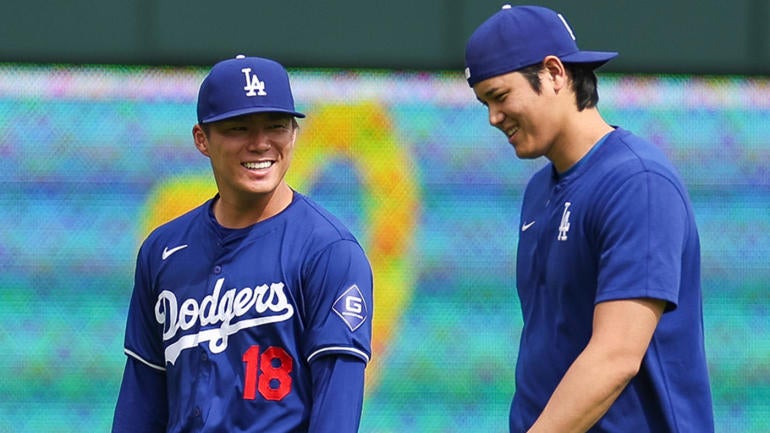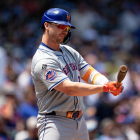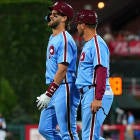
Blame it on fantasy and video games, trade simulators, "Moneyball," or any number of factors, but one dirty little secret of sports coverage is that a fair number of people these days have more interest in the team-building mechanisms than the contests themselves. With that in mind, we figured that Major League Baseball's season reaching the midway point would be the opportune time to indulge those folks by checking in on how last offseason's signings and trades have worked out to date.
To do that, we've broken down deals into subheadings across three categories: larger moves that have worked out; smaller moves that have worked out; and moves that haven't yet worked out. There's no hard and fast line of demarcation between the first two categories; we approach it with a simple rubric in mind: would this have merited a push notification? If we thought "yes," we threw it in the first group; if we thought "no," we threw it in the second group. (Be warned that our threshold for what merits a push notification may be higher than yours.)
Do note that we've jammed as many moves as we could into these categories, but that it's impossible to hit upon every single transaction in a tidy manner. Such is life.
Now, onto the good stuff.
Larger moves that have worked out
1. Dodgers bonanza
It's an accepted truth that winning the offseason doesn't always lead to winning the regular season. The Dodgers are evidence that it can -- provided your offseason bounty includes several elite players. Shohei Ohtani and Yoshinobu Yamamoto have validated their placement as the best free agents available last winter; Tyler Glasnow is averaging more than six innings per pop; and Teoscar Hernández is ensuring he won't have to settle for another one-year pact. Add in Jason Heyward, and five of the Dodgers' 10 most productive players this season (as judged by Baseball Reference's Wins Above Replacement metric) were winter additions or re-signings. Ultimately, this Dodgers group is going to be judged by a different metric -- World Series championships -- but provided they can get healthy over the second half, they look every bit as scary as they did on paper back in February.
2. Juan Soto
Ballplayers exist on a performance spectrum. You have replacement-level players, below-average players, average players, above-average players, and elite players. Winning teams tend to prioritize adding as many average and above-average players as possible and fielding as few below-average (or worse) players as they can. You can compete for a lot of playoff spots that way. What Soto (and the Dodgers) teach us is that you should never discount the impact gained by adding elite players. Whether or not Soto stays with the Yankees past this season, he's off to an incredible start that puts him on pace for a career year. Stacking Soto with Aaron Judge and Giancarlo Stanton explains why the Yankees rank near the top of the American League in runs scored despite below-average production from three-fourths of their starting infield. Elite players can cover for a lot.
3. Braves pitching additions
When people talk about teams who get the most from their pitchers, they generally highlight the Rays, the Guardians, and the Dodgers. The Braves are seldom mentioned, but it's clear to us that they belong. Despite losing ace Spencer Strider for the season, Atlanta's pitching staff has rolled right along thanks to some wise offseason additions. Chris Sale is en route to his best season in years (knock on wood that he stays healthy), and Reynaldo López's return to the rotation has played out far, far better than anyone could have reasonably expected. The Braves also look smart for betting on a rebound effort from lefty reliever Aaron Bummer; that trade cost them four depth pieces, and none of them have performed particularly well for the Chicago White Sox.
4. Both sides of Orioles-Brewers blockbuster
Back when Baltimore and Milwaukee agreed to the Corbin Burnes trade, we dug it more for the Orioles than the Brewers; we felt the Brewers should have gotten a little more in return, even if we liked Joey Ortiz and acknowledged DL Hall's potential. Halfway through the season, the deal has worked out well for both parties. Burnes has more than held up his end of the bargain, giving the O's a true workhorse ace. Ortiz, meanwhile, has hit a lot more than we expected, in the process serving as one of Milwaukee's most productive players. Hall's performance and injury are bummers, but the Brewers' ability to get more from their pitchers than expected -- have you looked at some of the names they're getting good mileage from? -- has made this more than tenable on both ends.
5. NL Central aces
We'll round out this section by pairing two National League Central starting pitcher additions that may have been overshadowed during the winter. Cardinals right-hander Sonny Gray is a three-time All-Star who has delivered for every team he's pitched for except that one season in the Bronx. His age and stature may have depressed his market, and that's proven to be a boon for the Cardinals. Shota Imanaga, meanwhile, was viewed as the other Japanese pitcher arriving in the States. Most evaluators we spoke to viewed him as more of a mid-rotation arm with some transferability concerns. He's been way better than that, to the point where he's been nearly unhittable at times.
Smaller moves that have worked out
1. Mets bets
David Stearns' first winter in charge of the Mets saw them load up on value propositions -- Sean Manaea, Luis Severino, Harrison Bader, J.D. Martinez, and some relievers -- who could serve two purposes: 1) keep the Mets respectable during the season's first half, and 2) recoup talent at the deadline if New York fell out of contention. Almost all of those additions have worked out as intended. It's to be seen how the Mets approach the deadline -- they, along with seemingly every other National League team, are technically still in the race -- but if the Mets do sell, Stearns' series of nifty additions may end up paying long-term dividends, too.
2. AL Central starters
The American League Central was something of a happening place over the winter. The Royals and Tigers did their best to improve their rosters for a playoff push, while the White Sox added a lot of depth pieces. Three of those moves in particular have worked out incredibly well: the Royals' addition of Seth Lugo; the Tigers' signing of Jack Flaherty; and the White Sox's gamble on Erick Fedde, who has proven that the changes he made while in South Korea have made him a viable big-league starter. If the season ended today, each of the three might receive at least down-ballot Cy Young Award consideration. Who would've thought that was possible coming into the year?
3. Gambles on former Cardinals
Flaherty isn't the only former Cardinals player flourishing elsewhere this season. The Giants' bet on Jordan Hicks as a starter has really paid off, with him showing more durability and command than could have been reasonably projected. Elsewhere, the Red Sox have to be pleased with how outfielder Tyler O'Neill has performed. Not only is he having his best offensive season in years, he's on pace to clear 100 games played for the second time in his big-league career. (The other time came in 2021.) Then there's White Sox shortstop Paul DeJong, a bargain-bin addition who matched last season's home run total in 40-plus fewer games. DeJong could be on the move for the second consecutive deadline -- just, um, don't look too long or too hard at his strikeout-to-walk ratio.
4. Joc Pederson
Because of injuries and some underperformance (including by some of their other offseason acquisitions), the Diamondbacks haven't followed up last fall's pennant win with the kind of vigor they may have hoped. Still, they deserve credit for nailing the Pederson signing (one-year with a mutual option for 2025). Pederson's ball-tracking data indicated that he had performed better last season than his triple-slash line indicated. Sure enough, he's returned to the form that earned him an All-Star Game appearance in 2022. We'll see if Pederson can keep up this level of performance heading forward, but he's one big reason Arizona stands a good chance of returning to the playoffs.
5. Red Sox's Rule 5 win
With due respect to the myriad other signings and trades that could have rounded out this section, we wanted to give flowers to a member of a largely unloved group: Boston's Rule 5 reliever Justin Slaten. The Mets picked Slaten from the Rangers for the Red Sox, who sent Ryan Ammons to New York in return. A few of the WAR models have Slaten as being one of the most effective relievers in baseball this season, and he owes that to a three-pitch mix that's heavy on cutters and sweepers. We've talked to front-office types over the years who think the Rule 5 Draft should be abolished because of how much better teams have gotten at evaluating their own players and managing their rosters; Slaten's season is a much-needed point in the Rule 5's favor.
Moves that haven't yet worked out
1. Pitching half of the Boras Four
A few weeks before the Giants inked Blake Snell, our friend and scribe Sam Miller made a prediction: whichever team signed Snell would come to regret the trade-off they made by waiting so long -- that is, getting more favorable terms at the cost of not affording Snell a normal spring training. Logic dictates that at least some of Snell's (and fellow Boras Four pitcher Jordan Montgomery) troubles are owed to that dynamic. Snell hasn't been able to settle into a rhythm yet either in part because of two stints on the injured list. When he has made it to the mound (all of six starts this season), he's looked bad, terrible or worse. Here's hoping he can finish the year looking more like his usual self.
2. Injured rotation additions
Speaking of disappointing free-agent pitcher seasons. Eduardo Rodríguez and Lucas Giolito were, alongside Snell and Montgomery, supposed to be two of the other top free-agent pitchers on the market last winter. Their signing teams (the Diamondbacks and Red Sox, respectively) guaranteed them nearly $100 million to solidify their rotations. Through no fault of their own, both have been non-factors this season -- and by that we mean they haven't combined for a single MLB appearance. Rodríguez is trending in the right direction as of late after suffering a setback from a spring lat issue; Giolito, meanwhile, will miss the entire campaign after requiring elbow surgery in the spring.
3. Mariners mess
The Mariners are well in front in the American League West, which makes us wonder: how much larger would their lead be if they had gotten more from their offseason additions? Luke Raley and Josh Rojas have been just fine; the same cannot be said of Jorge Polanco, Mitch Garver, or Mitch Haniger. (Luis Urías and Seby Zavala also earn a mention here.) Each of the three had their merits when they were signed or traded for; it just hasn't worked out. Maybe they can perform more like the versions of themselves the Mariners were hoping for the rest of the way -- if so, this season may culminate with Seattle's first division title since 2001.
In retrospect, we were far too bullish on Kiermaier when we ranked him as the 11th-best free agent last winter. The market clearly wasn't as enamored with him, resulting in a one-year deal worth just $10.5 million to rejoin the Blue Jays. We'll concede that the market was right and that we were wrong. Kiermaier, now in his mid-30s and with a CVS receipt-length injury history, has put forth a first half with no shortage of red flags. His strikeout rate is way up, his walk rate is down, and his quality of contact is down. He can still run and play a mean center field, but we can't blame the Blue Jays for giving Daulton Varsho more opportunities in center field as of late.
5. Small, smart bets on Astros relievers
Again, there were other deals we could have slotted in here. Our lizard brains couldn't overlook how the two least productive relievers with any sample this year were former Astros: Phil Maton (Rays) and Héctor Neris (Cubs). Both signed one-year deals with club options over the winter after stringing together quality seasons with the Astros, and both have faced similar troubles this year: cratering strikeout rates, spiking home-run and walk rates, and so on. We don't think there's much more to it than that, but it highlights how even "smart" bets on relievers can go awry in a hurry.


















